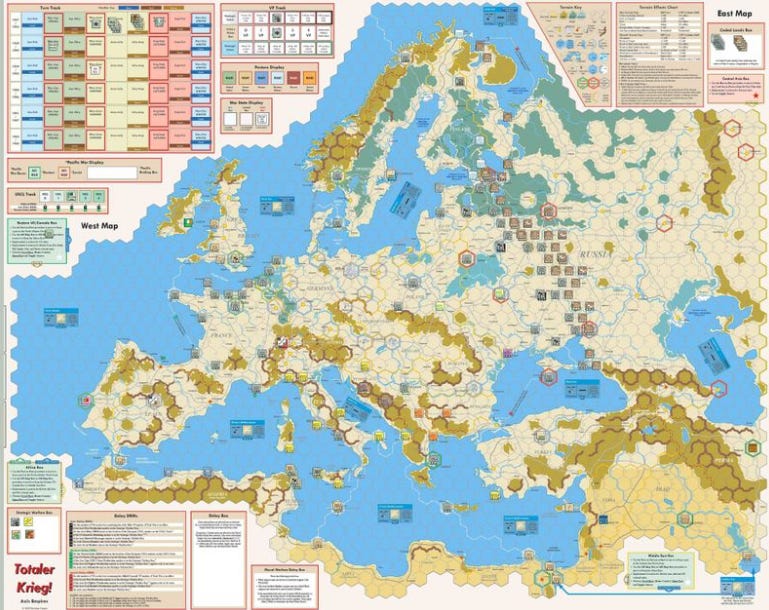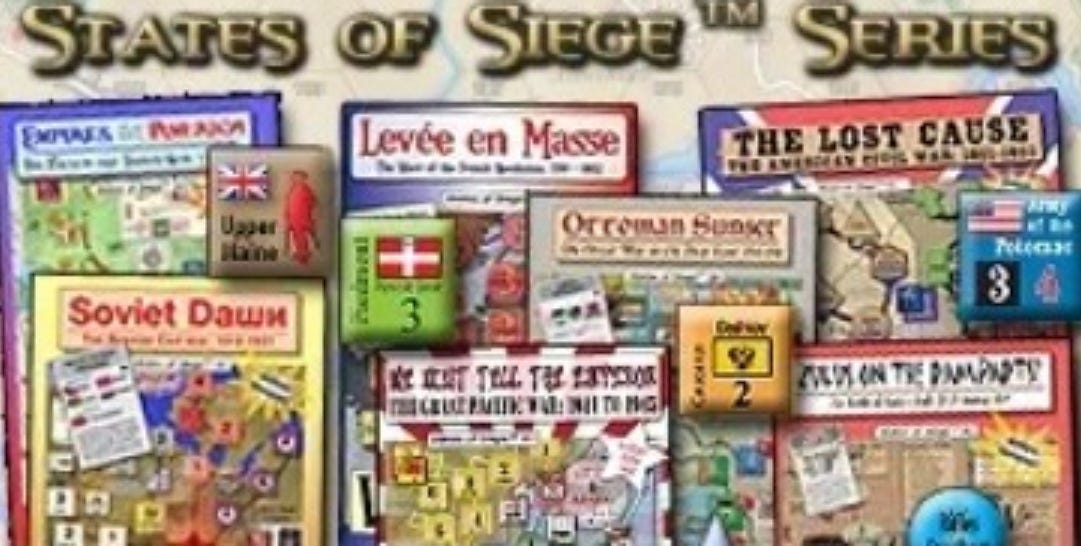I first met Alan in 1999. After a 15-year hiatus, I had decided to get back into boardgames. For some reason, Totaler Krieg! popped onto my radar and I was smitten. What really got my initial attention was this website full of strategy articles about the game. Who was the author of practically all those articles? You guessed it — Alan. Later, I acquired the Totaler Krieg! Player’s Guide. This was 90 pages of more discussion and analysis with some extra counters thrown in. Aside from Alan, there were at least a dozen other contributors. There is no fluff here. It was all deep and thoughtful writing. This was telling. Alan’s enthusiasm and ability to recruit and rally the troops was legendary.
Totaler Krieg!
For those who don’t know, Alan was the developer of Totaler Krieg! and its earlier incarnation as Krieg! Frankly, I consider it his masterpiece. Totaler Krieg! was your classic big-box strategic WW2 wargame with 500+ counters, 2 maps, 10 player aids, a rule book and a separate reference guide & designer notes. There was also 150+ cards, too. More about these later. This was a big and meaty package. Picking it up, you are struck by the weight of it all. A full campaign game literally takes three days.
For such a big game, gameplay was surprisingly elegant. Most of the time, there weren’t a lot of counters on the map. On your turn, you moved some pieces. You made a few decisions. Picked or played a card. Made a few die rolls. That was it. On the other guy’s turn, occasionally you countered one of his support units. Even in the late-war on the Eastern front, counter density was pretty manageable.
At first glance, Totaler Krieg! looks like a lot of other WW2 strategic wargames. Its beauty lies with its subtle riffs on concepts and the integration of them. As others have said, its sum was greater than its individual parts. This was fundamental to its elegance. A key concept throughout is design for effect. Instead of seeking to simulate at some granular level, the design pursues the effects to tell the story. For example, the retreat rules are a pure abstraction that exist to create certain effects the player feels and must respond to. The virtue is the efficiency of the gameplay.
Option Cards
A key component of this elegance is the 150+ Option cards included in the game. One of the ways Totaler Krieg! excels is moving beyond the notion that force and military power are the sole arbiters of conflict. It recognizes the intangibles of politics and abstracts the economic model. Each faction starts with all of their Option cards. These represent the summa of their faction’s capabilities across the spectrum of military capabilities, politics and economics. Moreover, these options represent trade-off moments. For example, as you mobilize Germany’s economy, you must discard certain options because you can’t build everything. If you decide to launch to launch Operations Sealion, that will alter future political and military options down the road. At a stroke, the player is making major political and economic decisions without the overhead of simulating them. You just pick an option that results in distinct outcomes and the player feels them in game terms.
Alan was at the heart of this design/development dynamic as he and the designer, Steven Kosakowski, worked through the vision for the game. All of these dynamics are copiously documented throughout the rulebook, reference guide and design notes and subsequent Player’s Guide. You can literally follow along as they think it through.
This experience was profound for me. In the past, I was definitely a casual gamer, the evangelist guy would get everyone excited to play the new game. But, I never thought deeply about design. I’d considered it. But, I found myself wanting on a bunch of different levels and quickly stopped thinking about design. More than anything, I didn’t care. I just wanted to play. With Totaler Krieg!, something changed. I found myself thinking more deeply about games and their design.
Of course, I started playing Totaler Krieg! Of course, there were some rule questions. I pinged Alan by email, a novelty at the time, and Alan, in his Emrich way, replied precisely and generously. His reply was the beginning of me thinking about boardgames in a disciplined way.
Fast forward a few years, I’m married with kids. Life is different. No time for epic games like Totaler Krieg! that take three days to play. In fact, the last time I played was the day before my wedding. The joke with my buddy was, “If she doesn’t show up, we’ll finish the game.” Alas, we never finished that game. Life is now very busy with family and work.
VPG & BGG
At this moment, I discovered BGG. We all remember that moment when we fall into this bottomless pit of games. As I explored, I learned Alan had started a game company called Victory Point Games. Interesting. VPG had this solitaire game called Soviet Dawn. Interesting. I’d played games solitaire my whole life, but typically to learn how to play. Here was a game designed to be played solo out of the box. Even better, the time to play was less than an hour. Perfect fit for me. Soon enough, I was playing Soviet Dawn a lot. More significantly, I started writing a lot about Soviet Dawn and other States of Siege games like We Must Tell the Emperor and The Lost Cause. One night, the Muse was upon me and I penned a light-hearted piece about losing the absurdly tiny VPG-issued die. This was my official introduction to VPG.
Thereafter, I was recruited as a playtester on various States of Siege projects. I’ll admit I didn’t know much. But, I did the work and watched the process. I met many talented people like Steve Carey, Darin Leviloff, Hans Vonstockhausen, Chris Taylor, Jeremy Lenart, Barry Pike and Wes Erni. It was an opportunity to apprentice. I dare say, I learned a few things. I even made a contribution or two. Eventually, Alan offered me a job at VPG. I was very fortunate to see classic games like Nemo’s War, Dawn of the Zeds 3rd edition, Darkest Night incubate and mature. BGG Con 2015 was fun. I think my most substantial contribution to VPG was late one night Alan and I were working. He started choking on something in his office. I rushed in and did a Heimlich maneuver to clear it. Good thing I remembered what I learned decades ago in high school. I emailed his wife, Petra, and we went back to work.
States of Siege
It is now very clear to me how the Option cards in Totaler Krieg! are of a piece conceptually with Event cards in States of Siege games. Obviously, the level of abstraction is completely different. But, the idea that the Event cards in a States of Siege game share some similar dynamics and characteristics is clear. They represent the summa of what could happen with the constraints of the specific narrative of the game (historical or otherwise). Moreover, the notion of triggered events is utilized in Totaler Krieg! and it makes sense to consider similar mechanics in States of Siege games. Indeed, the notion of Event cards in a States of Siege game makes a lot sense when thought of as “options”, or as I like to call them “initiatives” or resources.
Eventually, VPG and I parted ways. Later, VPG was sold. Like everyone else, I wish I’d kept in closer contact with Alan. Life tends to pull us apart as we journey on. Last fall, Alan and I discussed my son graduating from USMC boot camp. He was pleased.
It is curious how playing and thinking about games that Alan created and helped into being have profoundly affected me. Not a day goes by when I don’t think about one of them. I am grateful to have known and worked with Alan. Let us pray Alan is in a better place now and his wife, Petra, and their children will be able to endure the sadness of this moment. We all miss him very much.










